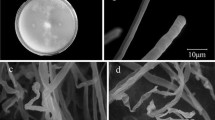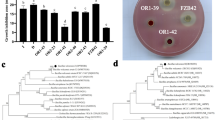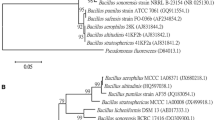Abstract
We investigated the effect of riboflavin on the biocontrol activity of Bacillus subtilis Tpb55 against Phytophthora nicotianae (Pn), which causes tobacco black shank. Riboflavin (0.2 mg ml−1) significantly improved the biocontrol activity of Tpb55 (2.0 × 108 cfu ml−1). Riboflavin (0.02–0.5 mg ml−1) alone could not significantly inhibit Pn growth. However, it enhanced the B. subtilis population, both in vitro and in tobacco roots and significantly increased the activity of defense enzymes, peroxidase, catalase, superoxide dismutase, and β-1,3-glucanase, in the roots of B. subtilis-treated tobacco seedlings. Our results indicate that riboflavin can stimulate the growth of B. subtilis Tpb55 and induce resistance to Pn in tobacco plants. These findings should boost the prospects for practical application of B. subtilis Tpb55 as a biocontrol agent against black shank of tobacco.



Similar content being viewed by others
References
Abo-Elyousr KAM, Hashem M, Ali EH (2009) Integrated control of cotton root rot disease by mixing fungal biocontrol agents and resistance inducers. Crop Prot 28:295–301
Aebi H (1984) Catalase in vitro. Methods Enzymol 105:121–126
Azami-Sardooei Z, França SC, Vleesschauwer DD, Höfte M (2010) Riboflavin induces resistance against Botrytis cinerea in bean, but not in tomato, by priming for a hydrogen peroxide-fueled resistance response. Physiol Mol Plant Pathol 75:23–29
Bradford MM (1976) A rapid and sensitive method for the quantitation of microgram quantities of protein utilizing the principle of protein-dye binding. Anal Biochem 72:248–254
Cao S, Zheng Y, Wang K, Tang S, Rui H (2009) Effect of yeast antagonist in combination with methyl jasmonate treatment on postharvest anthracnose rot of loquat fruit. Biol Control 50:73–77
Dennis JJC, Guest DI (1995) Acetylsalicylic acid and β-ionone decrease the susceptibility of tobacco to tobacco necrosis virus and Phytophthora parasitica var. nicotianae. Australas Plant Path 24:57–64
Falcón-Rodríguez AB, Costales D, Cabrera JC, Martínez-Téllez MA (2011) Chitosan physico-chemical properties modulate defense responses and resistance in tobacco plants against the oomycete Phytophthora nicotianae. Pestic Biochem Phys 100(3):221–228
Faoro F, Maffi D, Cantu D, Iriti M (2008) Chemical-induced resistance against powdery mildew in barley: the effects of chitosan and benzothiadiazole. BioControl 53:387–401
Farag MA, Fokar M, Abd H, Zhang H, Allen RD, Pare PW (2005) (Z)-3-Hexenol induces defense genes and downstream metabolites in maize. Planta 220:900–909
Feliziani E, Landi L, Romanazzi G (2014) Use of resistance inducers to control storage decay of sweet cherry. Acta Hortic 1053:227–235
Feng Y, Zhang M, Guo Q, Wang G, Gong J, Xu Y, Wang W (2014) Manipulation of monoubiquitin improves chilling tolerance in transgenic tobacco (Nicotiana tabacum). Plant Physiol Biochem 75:138–144
Francesco S, Vanneste JL, Costa G (2012) Acylcyclohexanediones and biological control agents: combining complementary modes of action to control fire blight. Trees 26:247–257
Geransayeh M, Abdossi V, Daliri MS, Zarrinnia V (2014) Antifungal activity of thymol, salicylic acid (SA) and methyljasmonate (MeJA) against postharvest pathogen Botrytis cinerea. Adv Bioresour 5(3):140–147
Han T, You C, Zhang L, Feng C, Zhang C, Wang J, Kong F (2016) Biocontrol potential of antagonist Bacillus subtilis Tpb55 against tobacco black shank. BioControl 61:195–205
Khan MIR, Asgher M, Khan NA (2014) Alleviation of salt-induced photosynthesis and growth inhibition by salicylic acid involves glycinebetaine and ethylene in mungbean (Vigna radiata L.). Plant Physiol Biochem 80:67–74
Li Y, Yin Y, Bi Y, Wang D (2012) Effect of riboflavin on postharvest disease of Asia pear and the possible mechanisms involved. Phytoparasitica 40:261–268
Liu F, Wei F, Wang L, Liu H, Zhu X, Liang Y (2010) Riboflavin activates defense responses in tobacco and induces resistance against Phytophthora parasitica and Ralstonia solanacearum. Physiol Mol Plant Pathol 74:330–336
Llorens E, Scalschi L, Fernandez-Crespo E, Lapena L, García-Agustín P (2015) Hexanoic acid provides long-lasting protection in ‘Fortune’ mandarin against Alternaria alternata. Physiol Mol Plant Pathol 91:38–45
Lurie S, Fallik E, Handros A, Shapira R (1997) The possible involvement of peroxidase in resistance to Botrytis cinerea in heat treated tomato fruit. Physiol Mol Plant Pathol 50:141–149
Neto ACR, Luiz C, Maraschin M, Piero RMD (2016) Efficacy of salicylic acid to reduce Penicillium expansum inoculum and preserve apple fruits. Int J Food Microbiol 221:54–60
Park K, Park J, Lee S, Balaraju K (2013) Disease suppression and growth promotion in cucumbers induced by integrating PGPR agent Bacillus subtilis strain B4 and chemical elicitor ASM. Crop Protect 54:199–205
Postma J, Stevens LH, Wiegers GL, Davelaar E, Nijhuis EH (2009) Biological control of Pythium aphanidermatum in cucumber with a combined application of Lysobacter enzymogenes strain 3.1T8 and chitosan. Biol Control 48:301–309
Rajkumar M, Ma Y, Freitas H (2008) Characterization of metal-resistant plant-growth promoting Bacillus weihenstephanensis isolated from serpentine soil in Portugal. J Basic Microbiol 48:500–508
Sahoo MR, DasGupta M, Kole PC, Bhat JS, Mukherjee A (2007) Antioxidative enzymes and isozymes analysis of taro genotypes and their implications in Phytophthora blight disease resistance. Mycopathologia 163:241–248
Stephen RJ, Anandaraj M, Sarma YR (2001) Induction of PR proteins and defense related enzymes in black pepper due to inoculation with Phytophthora capsici. Ind Phytopathol 54:23–28
Taheri P, Tarighi S (2010) Riboflavin induces resistance in rice against Rhizoctonia solani via jasmonate-mediated priming of phenylpropanoid pathway. J Plant Physiol 167:201–208
Taheri P, Tarighi S (2011) A survey on basal resistance and riboflavin-induced defense responses of sugar beet against Rhizoctonia solani. J Plant Physiol 168:1114–1122
Vandana VV, Suseela BR, Shamina A (2014) Biochemical defense responses of black pepper (Piper nigrum L.) lines to Phytophthora capsici. Physiol Mol Plant Pathol 88:18–27
Wang H, Chen X, Cai L, Cao Y, Lu N, Xia H, Wang M (2013) Race distribution and distribution of sensitivities to mefenoxam among isolates of Phytophthora parasitica var. nicotianae in Guizhou province of China. Crop Protect 52:136–140
Xin Z, Li X, Li J, Chen Z, Sun X (2016) Application of chemical elicitor (Z)-3-hexenol enhances direct and indirect plant defenses against tea geometrid Ectropis obliqua. BioControl 61:1–12
Zhang X, Sun Y, Yang Q, Chen L, Li W, Zhang H (2015) Control of postharvest black rot caused by Alternaria alternata in strawberries by the combination of Cryptococcus laurentii and Benzo-(1,2,3)-thiadiazole-7-carbothioic acid S-methyl ester. Biol Control 90:96–101
Acknowledgements
We thank Professor Enying Zhang in Qingdao Agricultural University for his help on data statistics. This research was financially supported by National Natural Science Foundation of China (Project No. 31000878), Hubei Province agricultural projects (Project No. 027Y2012-083), and Agricultural Science and Technology Innovation Program of China (Project No. ASTIP-TRIC07).
Author information
Authors and Affiliations
Corresponding author
Additional information
Handling Editor: Jane Debode.
Rights and permissions
About this article
Cite this article
Zhang, C., Gao, J., Han, T. et al. Integrated control of tobacco black shank by combined use of riboflavin and Bacillus subtilis strain Tpb55. BioControl 62, 835–845 (2017). https://doi.org/10.1007/s10526-017-9849-1
Received:
Accepted:
Published:
Issue Date:
DOI: https://doi.org/10.1007/s10526-017-9849-1




